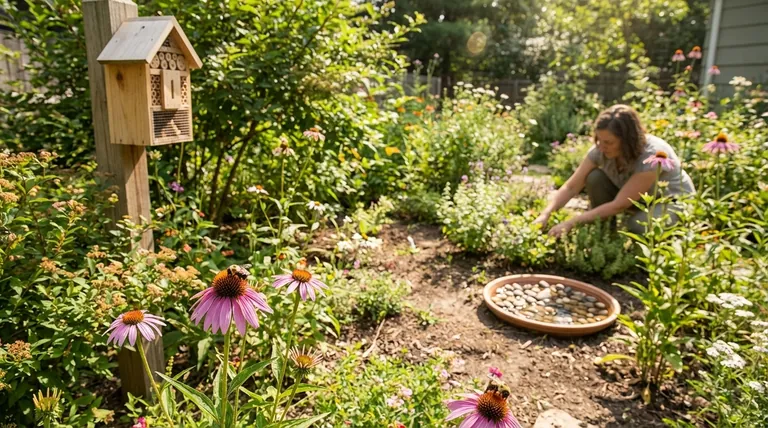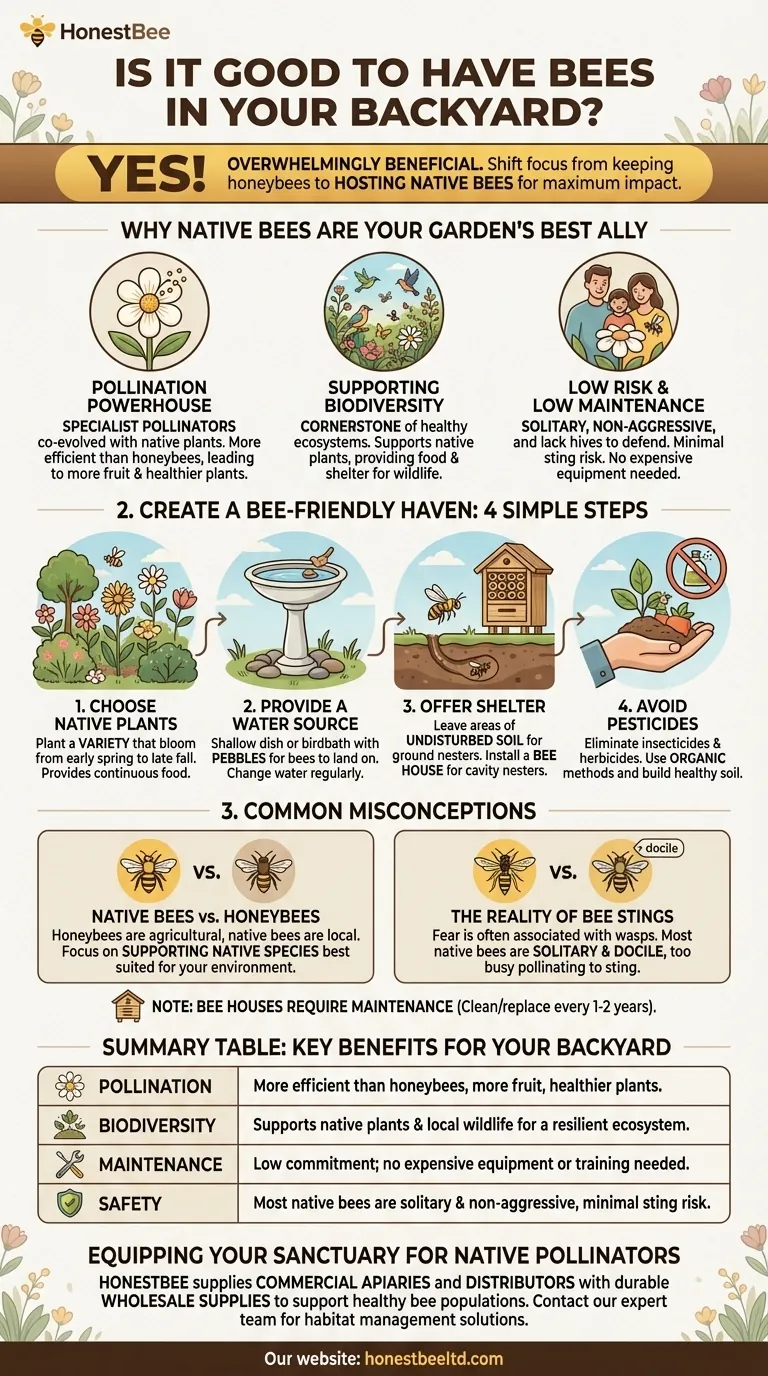In short, yes. Having bees in your backyard is overwhelmingly beneficial, not just for your garden but for the entire local ecosystem. The key is to understand that the most impactful action is not necessarily starting a honeybee hive, but rather creating a welcoming habitat for struggling native bee species.
The most effective strategy is to shift focus from "keeping bees" to "hosting bees." By cultivating a yard that supports your region's native pollinators, you directly improve biodiversity and the pollination of local plants with minimal effort.

Why Native Bees Are Your Garden's Best Ally
When people think of bees, they often picture the European honeybee. However, North America is home to thousands of species of native bees, and they are the unsung heroes of local ecosystems.
The Pollination Powerhouse
Many native bees are specialist pollinators, meaning they have co-evolved with native plants. They are often far more efficient at pollinating these plants—and many common garden fruits and vegetables—than honeybees.
This specialized efficiency leads to more fruit, healthier plants, and more vibrant flowers in your garden.
Supporting Local Biodiversity
Native bees are a cornerstone of a healthy environment. By supporting them, you are also supporting the native plants that depend on them, which in turn provides food and shelter for birds and other wildlife.
Your backyard becomes a small but vital link in the chain of a resilient local ecosystem.
Low Maintenance, Low Risk
Unlike the significant commitment of beekeeping, attracting native bees is simple. You don't need expensive equipment or extensive training.
Furthermore, most native bees are solitary and non-aggressive. They lack a large hive to defend, so the risk of being stung is extremely low, making them safe neighbors for families and pets.
How to Create a Bee-Friendly Haven
Transforming your yard into a sanctuary for native bees is straightforward and rewarding. It revolves around providing three basic needs: food, water, and shelter.
Choose Native Plants
The single most important step is to plant a variety of native wildflowers, shrubs, and trees. These provide the specific pollen and nectar that local bees require.
Aim for a mix of plants that bloom at different times, from early spring to late fall, to provide a continuous food source.
Provide a Water Source
Bees need water to drink and cool their hives. A simple birdbath with pebbles or marbles for them to land on is perfect.
A shallow dish filled with water and stones works just as well. Ensure you change the water regularly.
Offer Shelter
About 70% of native bees nest in the ground, so leaving some areas of bare, undisturbed soil is beneficial.
For the other 30% that nest in wood or hollow stems, you can install a "bee house." These simple structures provide nesting tunnels for solitary species like mason bees and leafcutter bees.
Avoid Pesticides
Insecticides, herbicides, and other chemicals can be lethal to bees and other beneficial insects. Eliminating their use is critical to creating a truly safe haven.
Opt for organic pest control methods and focus on building healthy soil to grow resilient plants.
Common Misconceptions to Avoid
Building a bee-friendly yard is simple, but understanding a few key distinctions will ensure your efforts are as effective as possible.
Native Bees vs. Honeybees
Honeybees are not native to North America; they are an agricultural species from Europe. While vital for large-scale agriculture, they can sometimes outcompete native bees for resources.
Focusing on native bees ensures you are supporting the species that are most in need and best suited for your local environment.
The Reality of Bee Stings
The fear of stings is often associated with yellowjackets, which are a type of wasp, not a bee. Most native bees are solitary and docile.
You can work in your garden alongside them without fear. They are far too busy pollinating to be concerned with you.
"Bee Houses" Require Maintenance
While bee houses are beneficial, they are not a "set it and forget it" solution. To prevent the buildup of parasites and disease, nesting blocks should be cleaned or replaced every one to two years.
Making the Right Choice for Your Goal
Creating a bee-friendly yard is a scalable effort. You can start small and still make a significant difference.
- If your primary focus is a more productive garden: Plant a diverse mix of native flowers among your vegetables to attract efficient native pollinators.
- If your primary focus is supporting local wildlife: Prioritize planting native species that provide blooms across three seasons and leave some areas of your yard "wild."
- If your primary focus is a low-maintenance, beautiful yard: Simply replacing some of your lawn or traditional ornamentals with hardy native wildflowers will attract bees with minimal effort.
By taking these small steps, you can transform your backyard into a vital sanctuary that supports the health of your entire community.
Summary Table:
| Key Aspect | Benefit for Your Backyard |
|---|---|
| Pollination | More efficient than honeybees; leads to more fruit and healthier plants. |
| Biodiversity | Supports native plants and local wildlife, creating a resilient ecosystem. |
| Maintenance | Low commitment; no expensive equipment or training needed. |
| Safety | Most native bees are solitary and non-aggressive, posing minimal sting risk. |
Ready to equip your sanctuary for native pollinators? HONESTBEE supplies commercial apiaries and beekeeping equipment distributors with the wholesale supplies needed to support healthy bee populations. Whether you're a large-scale habitat manager or a distributor providing for your community, we have the durable, effective equipment to help you succeed. Contact our expert team today to discuss your wholesale needs and enhance your impact on local biodiversity.
Visual Guide

Related Products
- Wooden Bee Brush with Triple Row Artificial Fiber for Beekeeping
- Professional Hive Front Entrance Bee Feeder
- HONESTBEE Entrance Bee Feeder Efficient Hive Front Liquid Feeding Solution for Beekeeping
- Professional In-Hive Bee Feeder HONESTBEE Frame for Beekeeping
- JZBZ Langstroth Queen Rearing Frame for Beekeeping
People Also Ask
- Why do beekeepers use a bee brush? The Essential Tool for Gentle Bee Handling
- Is a bee brush used to harm bees? Learn the Proper Tool for Gentle Beekeeping
- What is the purpose of a bee brush? Gently Manage Your Hive with Precision
- What are the key features of a popular bee brush? Essential Design for Bee Safety and Hive Hygiene
- How does using a bee brush benefit beekeepers and the hive? Achieve Gentle, Stress-Free Hive Management



















